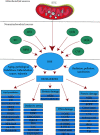Targeting Oxidative Stress Mechanisms to Treat Alzheimer's and Parkinson's Disease: A Critical Review
- PMID: 35958022
- PMCID: PMC9357807
- DOI: 10.1155/2022/7934442
Targeting Oxidative Stress Mechanisms to Treat Alzheimer's and Parkinson's Disease: A Critical Review
Abstract
Neurodegenerative disorders such as Alzheimer's disease (AD) and Parkinson's disease (PD) are becoming more frequent as the age increases. Contemporary therapies provide symptom resolution instead of targeting underlying pathological pathways. Consequently, there is considerable heterogeneity in response to treatment. Research has elucidated multiple potential of pathophysiological mechanisms contributing to neurodegenerative conditions, among which oxidative stress pathways appear to be suitable drug targets. The oxidative stress pathway has given rise to numerous novel pharmacological therapies that may provide a new avenue for neurodegenerative diseases. For example, SKQ (plastoquinone), MitoVitE, vitamin E, SOD mimic, MitoTEMPO (SOD mimetic), and bioactive molecules like curcumin and vitamin C have indeed been examined. To better understand how oxidative stress contributes to neurodegenerative diseases (such as Alzheimer's and Parkinson's), we analyzed the medicinal qualities of medicines that target markers in the cellular oxidative pathways. The specific pathway by which mitochondrial dysfunction causes neurodegeneration will require more investigation. An animal study should be carried out on medications that tackle cellular redox mechanisms but are not currently licensed for use in the management of neurodegenerative conditions.
Copyright © 2022 Abdullahi Tunde Aborode et al.
Conflict of interest statement
The authors of this research disclose that they have no competing interests in its manuscript.
Figures
References
Publication types
MeSH terms
Substances
LinkOut - more resources
Full Text Sources
Medical





